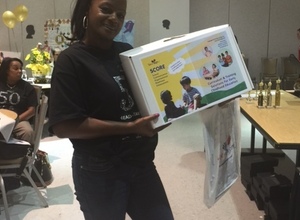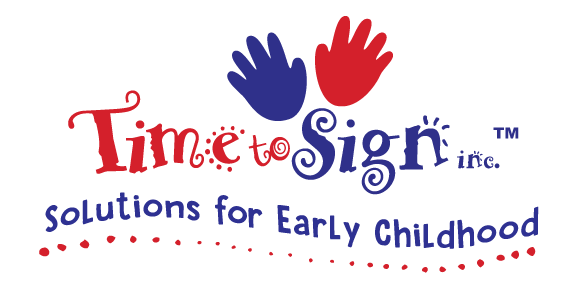Time to Sign SCORE Winner

New Score Curriculum Program from Time to Sign... Congratulations to Hillsborough County Head Start Winner of for her classroom...
Our S.C.O.R.E. (School, Communication, Organizational, Readiness, Enhancement) Program helps in the early development of our children.
Hubler: Sign language helps kids develop
According to American Sign Language guru Lillian Hubler, the signs all point out to signing's singular ability to help kids develop in many ways.
Kids also take to signing like ducks to water, which makes it a cinch to teach.
"It is easier for children to learn sign than it is the spoken word, because 80 percent of signs are pictorial representations of the concept they represent," said Hubler, who by the way, is married to South Brevard Sharing Center director and 2013 FLORIDA TODAY Citizen of the year Mike Hubler.
In 2000, Hubler launched Time to Sign, a Brevard-based educational company that teaches signing around the world, so she spends her day flitting out of town to teach signing hither and yon.
She never tires of singing - and signing - the praises of her favorite language. While most of her presentations are out of town, Brevard residents can tap into Hubler's signing expertise during a seminar scheduled for Dec. 12 in Palm Bay.
Why did you become interested in signing?
Sons 2 of 3 had issues of remission after my divorce in 1998. I was told by a good friend to try signing with him.
I thought that if he is not speaking, how would sign language help? She explained and I later found it out to be true, that it would be your own special time together and would ensure that even if he was not verbal, he would still be learning the necessary toddler concepts. So I began signing with him and it did indeed bring him out of his shell.
How did things go pro?
Soon thereafter his day care center asked if I could sign with his entire class, then the whole school. My neighbors also wanted to learn, so I started classes in my home for the moms and their kids throughout the neighborhood.
This eventually grew into the global business we have today, which includes many different training opportunities, as well as resource materials and curriculum to incorporate sign language into every facet of early childhood education.
Is it easier for younger children to learn sign language than it is for adults and teens?
Yes, definitely. Young children can learn and differentiate between five different languages simultaneously until about the age of 7, on average.
Prior to this age, all communication information is stored in a single cluster behind the left ear. After this, additional languages are stored in an adjoining separate cluster for each language learned.
Thus, when you take a language in high school or college you have to force yourself to turn off your English to speak the other language. This is how the separate clusters work. So early languages are stored in the better central permanent recall area of the brain. This is also why languages learned later in life are easily forgotten if not used.
How can signing help normally developing children?
Learning to sign increases IQ's of children from 8-10 points per child. It boosts concept understanding and literacy. Signs give the child an additional better way of learning concepts as it is visual. It serves as a secondary system, so children have two ways to understand and recall the concepts. For visual children, about 30 percent of the population, it is much better than the spoken word.
Any other benefits?
It increases children's vocabulary, provides preverbal communication skills and enhances fine and gross motor skills. Signing children will spill less milk at the table!
It improves social and emotional development and functional communication skills necessary for success in school and life and gives them tools for positive expression of emotions.
How about in the classroom?
It reduces noise levels in the classroom and the need for the teacher to raise her voice. It makes classrooms special needs-friendly. The No. 1 reason exceptional children leave mainstream programs is that they do not have any playmates or fun. Using sign opens up the communication door for exceptional children to flourish.
How long does it take for a young child to learn basic signing?
Immediately. Our third son was able to sign "milk" at five months. We simply did the sign when we gave him milk and after about half a dozen times, he figured out that when he did the sign for milk, it would be brought to him. Reduced his and our frustration because he did not have to squawk or cry to get what he wanted.
How did signing help your own kids?
Son No. 2 went from reverting behaviorally and with his communication to starting kindergarten at age 4.
Son No. 3 at the age of 14 plays three instruments, is in flight school to get his private pilot license, has published a 130-page science fiction fantasy novel available for purchase on Amazon and was the first Future Problem Solver student to go to the International Writing Competition from Hoover Intermediate. He placed as a finalist. His intellect and abilities were directly positively affected as he was our test baby who was immersed in sign language early in life.
Sign Language for Social and Emotional Learning
When: 5 to 7 p.m., Friday, December 12, 2014 Where: The Knowledge Exchange, 5151 Babcock Street, NE, Palm Bay Cost: $25.00 Register: By phone at 321-726-9466
Maria Sonnenberg is a freelance writer based in Melbourne.
Source: Florida Today
Tags: hillsborough head sthead starthillsborough fl






PO Box 33831
Indialantic, FL 32903
Call Us: (321) 726-9466